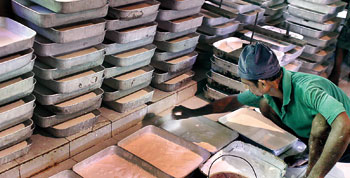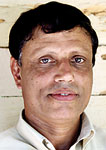There is a strange excitement on the seventh day of every month in this sleepy village set in a beautiful pastoral environment. Posh vehicles make their way from Warakapola and instead of taking the high road, come sliding down the low, to a rustic shed.
Away from the madding crowd sharp at 3 in the afternoon bids are opened and tiny slips of paper with a figure written on them thrown down. It is an auction.
It is about 65 km from Colombo and having laid out their wares, lovely golden-coloured rubber sheets encrusted with “diamond shapes” this auction brings equal or better prices than the Colombo auction itself.
 |
| B.A. Wimalasena at the processing centre. Pix by M.A. Pushpa Kumara |
The road to this point, however, has been long and steep for the Pandeniya Thurusaviya Samithiya which is now reaping double rewards – a good price for its rubber and international recognition. This is the first rubber smallholder group not only in the country but in the world to win “certification” for its latex from the Forest Stewardship Council it is learnt.
Trial and error had been their path with regard to marketing strategies, although their sweat and toil produced good rubber. For generations rubber has been their livelihood, a weary one at that when in the 1980s they would do the tapping of milk, rolling and drying the sheets and then take them as individual sellers to traders in the town of Warakapola closest to them. They were at the mercy of the traders, who set the price and the smallholders were helpless because the quality of their rubber may not have been too good.
“We carried the stacked sheets on our heads and walked nearly eight km for paltry earnings, when considering the time and effort put in,” recalls the livewire of the Pandeniya Thurusaviya Samithiya, the Secretary of the Working Committee, J.M.D. Berty Lionel.
Epa wela thibbe, sighs Rupasena Balasuriya who owns a two-acre plot with rubber, explaining that he was fed up with his livelihood.
 |
| Lionel |
Flanked by President E.A.G. Ekanayake and Treasurer M.P. Nihal Premathilake who chip in on and off, the rags-to-riches story of these rubber smallholders unfolds. (Currently, the 11-member Working Committee includes two women, with the samithiya membership which comprises 34 having seven women.)
Conditions were harsh, with a lacuna of facilities. The smallholders ranged from those who had quarter-acre with about 50 rubber trees to others who had five acres. Most of them tapped the rubber milk (latex) themselves, processed it and carried it to town. With no training, the methods were primitive.
In desperation, by 1983 the smallholders got together and formed a Grama Sangwardena Samithiya (village society) and sought land from the government to take their livelihood to a different level. Having lobbied for land from the then Member of Parliament for Dedigama, Dr. Nissanka Wijeyeratne they secured not only a plot of land for their rubber processing activities but 25 acres in all, with blocks for the temple, school, cemetery, community centre and playground but also 33 nearly-half-acre plots for those in the Nakandamulahena jana padaya who did not have land of their own.
As the land given to them to enhance their work already had a small processing centre, the society requested the Rubber Research Institute officials at Ratmalana to lend a hand to fortify the facilities. Urging them to set up a cooperative society – which the smallholders did -- as the Seemasahitha Pandeniya Rubber Nipadavanan Saha Alevikarannange Samupakara Samithiya the RRI provided a loan and equipment.
Whereas processing, smoking and storing the rubber sheets had been done individually, now they were able to set up a collective processing centre, smoke room and store-room.
The time also seemed “right” for these rubber smallholders. Under a training the trainer programme by the RRI’s advisory unit among those who benefited was Lionel while under a pilot project of the Plantation Ministry’s Thurusaviya Fund they were able to secure a roller operated on electricity.
“It took three people and six hours to roll the sheets manually, the electric roller needed only one person and 1 1/4,” says Lionel.
Although by now they were selling their sheets as a group to the coop in the village and later to traders in the town, the prices were still unsatisfactory.
Strength in collectivity giving them more muscle, it was in 1992 that they decided as their product was of quality, instead of going to the buyers to get the buyers to come to them.
This saw the birth of the rubber auction at Pandeniya every 7th of the month. But all issues had not been sorted out – the buyers brought money with them and there was danger not only in them getting waylaid and robbed but also once the auction was over and the villagers took their cash, their homes being burgled.
The fine-tuning of the system came thereafter with the buyers arriving sans the money, bidding for the rubber sheets, the highest bidder securing the lot, an unwritten agreement and then the successful buyer depositing the price at the Warakapola People’s Bank which in turn credited it to the different accounts of the smallholders as per the instructions of the committee, points out Lionel.
As the Pandeniya Thurusaviya Samithiya grew and blossomed, with the tiny membership fee collected, the committee also gave out kshanika naya (small loans or micro-finance), says Lionel.
Long years ago even after much toil and trouble, the smallholders were only able to collect Rs. 18 per kilo but now with five or six buyers coming from as far as Avissawella and Maharagama or as close as Kegalle and Weweldeniya to their doorstep, a kilo fetches the market rate or slightly more.
Usually each month’s auction sees more than 4,000 kilos going under the gavel netting in about Rs. 2 million, but most of all the Pandeniya Thurusaviya Samithiya has become a model for all rubber smallholders spread across the country.
Rubbery beginnings
A lesson that is all about rubber is learnt by the Sunday Times, with rubber-maker G.P.D. Gamini Upatissa explaining that tapping is carried out only during the dry season.
Tapping which means grooves being cut on the trunk of mature trees is done early morning after which it is kept for about one hour for the milk or latex to flow into the coconut shell fixed below the grooves.
Once the tree yields its quota, natural coagulation takes place and it is then that the tappers go round collecting the milk into big buckets and converge on the processing centre. There, the latex is put through a sieve to remove impurities and poured into trays, similar to the ones in which people bake cakes.
Each tray holds 1.5 litres of milk and to this water, sodium and acid are added, says Upatissa, while B.A. Wimalasena who has tapped 60 trees is getting about his work, removing the foam that gets formed atop and collecting it in another dish. The smallholders’ trays are then marked with a seal which is the individual’s society membership number.
Next morning, the latex has set into sheets and each sheet is sent through the roller. If it is the manual roller it has to be done three times and then through the “diamond roller” which leaves behind tiny diamond shapes on the sheet, to quicken the drying process, says Upatissa. If, however, it is the electric roller, once is enough and out comes the dried sheet diamond shapes and all.
Given a “bath” once again, the water is allowed to drip down before the sheets are strung up on racks in the dung ge (smoke room), to which smoke is channelled from a furnace fuelled by firewood. Thereafter, the sheets are counted and kept in the store room, awaiting auction.
On the road to international recognition
The latest jewel in the crown of the Pandeniya Thurusaviya Samithiya is securing international certification from the American-based Forest Stewardship Council (FSC) in March this year.
The events that climaxed in FSC certification, which is from 2011-2016, were set in motion when Chairperson Ranjith Gunasekera of Help for the Children, a non-governmental organization, was contacted by a colleague from abroad, Dr. Martin Kunz, with the offer of helping a rubber smallholder society. When Mr. Gunasekera in turn asked the Thurusaviya Fund he had been directed to the Pandeniya Thurusaviya Samithiya as the “best”.
Three years and rigorous preparations later, the samithiya’s latex has got FSC certification and its first sale has been to Ceytra Pvt. Ltd., at Horana in the production of hats for the British market under the Fair Trade System.
The first lot brought us in addition to the Colombo auction prices, a premium of Rs. 75 on each kilo, says Lionel.
The samithiya will also be the beneficiary of a rubber-dryer using a bio-gas digester under the Fair Trade System, to be constructed by 83-year-old G.K. Upawansa, formerly of the Agriculture Department, Peradeniya, which is more environmentally-friendly than burning firewood.
FSC is an independent, non-governmental, not-for-profit organization which promotes responsible management of the world’s forests, the Sunday Times learns. Through this pioneer forum, voices from the North and South, from organizations big and small, assemble to define environmentally appropriate, socially beneficial and economically viable forest management and identify tools and resources that will effect positive, lasting change, its website states. “FSC certification provides a credible link between responsible production and consumption of forest products, enabling consumers and businesses to make purchasing decisions that benefit people and the environment as well as providing ongoing business value, it is understood.
Represented nationally in more than 50 countries, FSC has membership status with the International Union for Conservation of Nature (IUCN) and the International Social and Environmental Accreditation and Labelling Alliance (ISEAL). |




